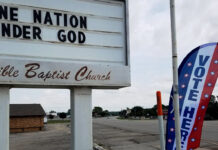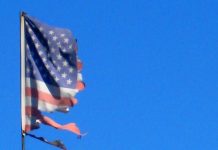
Composed by Thomas Jefferson. Approved on July 4, 1776. First signed by John Hancock with the large, swashbuckling strokes of his fountain pen. And aside from the fact that it just so happens to be the document that first established our nation of the United States of America, what else is there to know, right?
Well, plenty, it turns out, and in categories that range from trivia to history rewritten. On this 238th Anniversary of our country’s foundation, enjoy these eight fun facts about the launch of our Liberal American nation! Who knows? You might learn something new and liberal!
1) Only two delegates signed the Declaration on July 4.

We all know John Hancock was the first to sign the Declaration of Independence, doing so on the July 4 date it bears. But he was one of only two to sign it that day (the second was delegate Charles Thomson). The Continental Congress actually approved the last proposal of the document at its convention on July 2, then voted to formally adopt the final version two days later. The delegates returned to their homes right afterward, though. Only Hancock and Thomson remained present to sign it on the day the last edition of the document was created, and it wasn’t until the Congress reconvened on August 2, 1776 that almost all the other delegates could add their signatures. (It took until 1781 before the last and 56th delegate, Thomas McKean, signed.)
2) It didn’t pass unanimously at first.

The final version of the Declaration of Independence was presented to the Congress on June 28, 1776. A vote on July 1 got “no” votes from two colonies – Pennsylvania and South Carolina – while New York abstained. After debates continued, Pennsylvania and South Carolina delegates changed their votes on July 2, which got the Declaration approved. Several days later, New York removed its abstention to vote in favor, finally making approval unanimous among the 13 colonies.
3) One of the signers recanted after signing.

New Jersey delegate Richard Stockton signed the Declaration on August 2, 1776, but declared allegiance to King George just six months later, formally retracting his endorsement of the document and its message. It’s not like Stockton had changed his mind, though; he simply wanted to live.
In November 1776 Stockton was captured by British loyalists and sent to prison in New York. The conditions of his confinement were deplorable, too, with many prisoners dying of hunger. Stockton took the offer to swear allegiance to the King to regain his freedom, but declared loyalty to the U.S. shortly after.
4) The original Declaration of Independence called for an end to slavery.

The Declaration of Independence we know of is not the same one that was first presented to the Continental Congress. The original draft that Jefferson composed included a paragraph calling for an end to the “cruel war against human nature itself.” It attacked England’s King George for first creating the slavery market in the colonies, and for later trying to incite slaves to rebel only in support of his rule.
Unfortunately, the paragraph had to be retracted due to protests from slave-owning convention delegates. Years later, Jefferson identified those contesting delegates to be those from the southern colonies of South Carolina and Georgia, as well as some northern delegates who were involved in slave trade.
Here’s that anti-slavery paragraph that appeared in the first draft of the Declaration:
“[King George] has waged cruel war against human nature itself, violating its most sacred rights of life and liberty in the persons of a distant people who never offended him, captivating & carrying them into slavery in another hemisphere or to incur miserable death in their transportation thither. This piratical warfare, the opprobrium of infidel powers, is the warfare of the Christian King of Great Britain. Determined to keep open a market where Men should be bought & sold, he has prostituted his negative for suppressing every legislative attempt to prohibit or restrain this execrable commerce. And that this assemblage of horrors might want no fact of distinguished die, he is now exciting those very people to rise in arms among us, and to purchase that liberty of which he has deprived them, by murdering the people on whom he has obtruded them: thus paying off former crimes committed again the Liberties of one people, with crimes which he urges them to commit against the lives of another.”
5) The convention made 200 copies of the Declaration.

The delegates who signed the document needed copies to bring back to their colonies for local conventions, as well as to military leaders. The official printer to the convention was John Dunlap, who produced 200 copies of what are today known as the “Dunlap Broadside” editions.
The actual original is displayed in the National Archives in Washington, D.C. The whereabouts of most of the Dunlap copies are unknown, though, and may be either lost or destroyed. Twenty-two known editions are displayed in various libraries and museums in the U.S., and another three are owned and displayed by the British National Archives.
6) That’s not paper it’s printed on.

Don’t get too excited, tree-huggers; the “Dunlap Broadside” versions of the Declaration of Independence were printed on paper. Make room for a PETA demonstration, though, because the original document is printed on animal skin.
That’s what parchment is, alright – the skin of calves, sheep and goats, and which holds ink pretty well after it’s been pulled tight, scraped, and limed. It can’t be exposed to humidity, though, which is why the original on display at the National Archives is kept in an airtight encasement.
7) Yes, “National Treasure” fans – there is something written on the back of the original document.

We’ve all seen the movie in which Nicholas Cage steals the Declaration, and uses a prism to read secret clues on the back. Turns out that action flick wasn’t entirely fiction, although not to the Hollywood degree depicted in the film.
On the rear side of the parchment, appearing upside down near the bottom, is it written “Original Declaration of Independence, dated 4th July, 1776.”
8) Our Declaration of Independence influenced many other countries to make their own.

Not only did it declare the U.S. to be an independent nation, but so well-crafted was the Declaration that at least 26 other countries used it as an example when creating their own declarations. Just 12 years after ours was adopted, France produced its Declaration of the Rights of Man and Citizen, and with direct aid from the same Thomas Jefferson who composed the U.S. Declaration.
In the first half of the 19th Century, 18 nations in the Caribbean, Central America and South America even copied portions of the U.S. document when forming their own. The now-states of California and Texas also borrowed from the U.S. version when making their own Declarations. Other countries include New Zealand, Czechoslovakia and Hungary, and its influence was felt even as late as 1965, when Rhodesia based its Declaration of Independence on that of the U.S.
Let us know your thoughts on the Liberal America Facebook page!
Updated on July 1, 2017 by MT.




